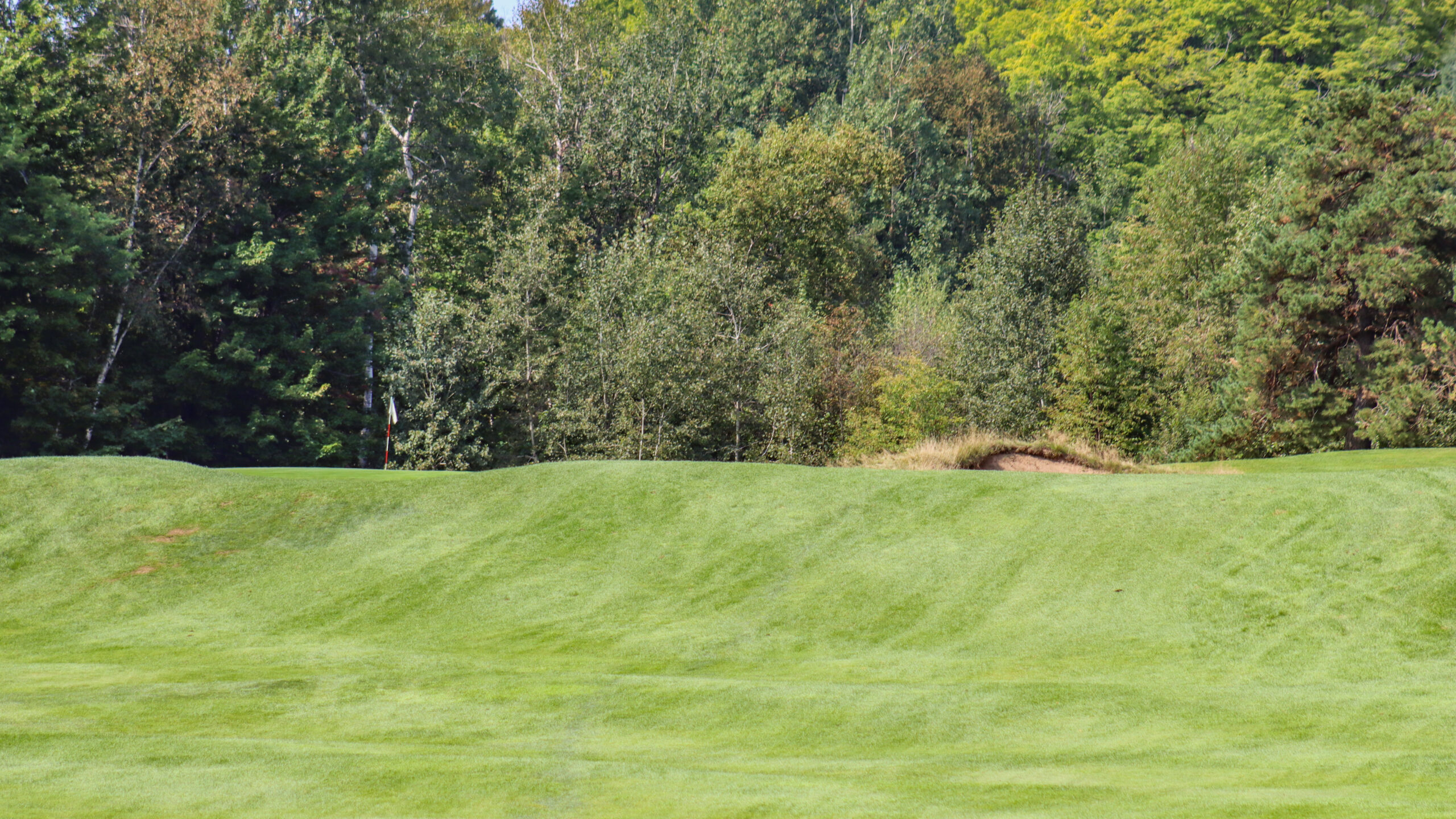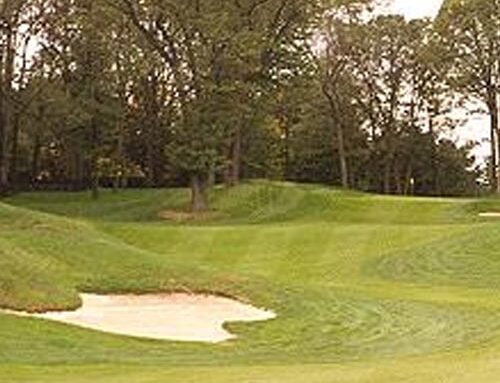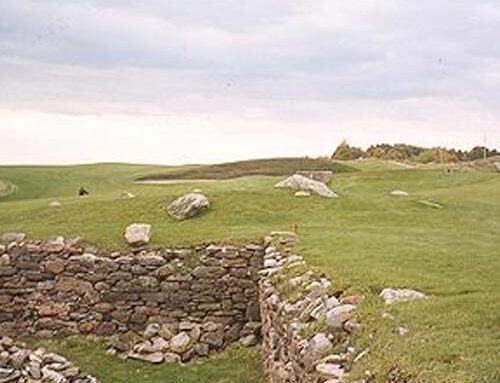As society progresses, regions of the world get left behind for new, booming areas. As a result, there will inevitably be golf courses that fall behind the curve that were once in prominance. Hotbeds where society had once flocked to eventually evolve into sleepy towns on the outskirts of society. Yet, all the evidence of a booming region remain, just slowly deteriorating as the major metropolitans expand. That remains the case with Grand-Mere in the town of Shawinigan, Quebec, somewhere halfway between Montreal and Quebec City.
Beginning in the early 1900s, the Laurentide Company, an American-based pulp & paper company, began to explore ways to improve their working conditions at their Shawinigan location in the heart of Quebec’s idyllic setting at the base of the mountains running through the province’s core. George Cahoon, an executive at the company, hired a man by the name of Frederik de Peyster to layout three golf holes, and in 1912, those three holes opened for play. Quebec-based architect Albert Murray swiftly came in three years later and expanded the layout to nine holes in 1915, followed by Walter Travis revolutionizing that nine hole layout in 1917, and finally, Charles Hugh Alison expanding the golf course to eighteen holes in 1922.
Following Alison’s visit in 1922, Grand-Mere largely became a golf course forgotten and frozen in time. Society began to progress and the Laurentide Company’s pulp mill in town closed some fifty-years later. With no reason for visitors to come to Shawinigan and a lack of money in the town, the course became a byproduct of an old era. To this day, that golf course Alison left in 1922 is 95% there, with very few changes since.
Things have evolved over time in the town and it is certainly not the same place that it was in the 20s, but one thing remains equally true as it did over a century ago: this Walter Travis and C.H. Alison is a joyful golf course well worth the time, effort, and energy to see it.
Holes to Note
Second hole, 370 yards; Perhaps the most brash introduction to a golf course in Canada after a relatively benign opening par 5, the 2nd hole doglegs severely around the property’s edge up the entire left side. So much, in fact, that the golfer seemingly plays more than 90 degrees to the left around the corner. Sure, the tee shot might be the least interesting singular swing on property—a straight shot of some 220 yards from the back teeing ground—but what it reveals around the corner is the real watershed moment for Grand-Mere doubters: the rollicking terrain, capsized by Walter Travis’ severe, pushed up green falling off on all edges and the ruggedness of middle Quebec is on full display.

Fourth hole, 300 yards; golf in Canada is largely celebrated by its par 3’s on the coast at Victoria, BC or Cabot Cape Breton, the mountainous renditions at Banff Springs, Greywolf, or Jasper Park Lodge, or perhaps a plethora of fine drive-and-pitch holes from a variety of architects across the country. Drivable par 4’s are a rarity in the country, especially of the highest regard. That all becomes null and void upon stepping on the fourth tee box, a superb example and where the layout truly begins to elevate itself to the next level. True, the golfer walks past the slope-y Travis green’s at the 3rd and 9th, as well as the tee shot on the 4th on their way to the opening tee ball at Grand-Mere, but upon the golfer’s arrival at the tee, a decision is immediately brought onto the golfer:
- The tee shot’s view from the tee gives a mere glimpse of what’s over the ridge…
- …but upon cresting the hill, there is nearly 100 yards of space between the two!
Deciding when (and how) to play over the ridge is largely the question at hand, but it is not quite as simple as that sounds. For one, laying back to a comfortable number of 100 yards or so leaves a blind approach shot over the ridge. The green is large, but with a considerable amount of slope, playing to the right portion of the green is paramount. For those aggressive, or anyone who can carry driver over 200 yards, playing up the left sets up the opportunity to get home in two, though it is a strong tee shot. A feeder slope up the left ushers balls back towards the centre of the green, but missing left of the ridge provides the most difficult pitch on the hole. Bailing out right means a chip shot over the two menacing bunkers, but plays into the contour and is a much easier second shot than it visually appears.
- The micro contours up the left make all the difference between a tee ball getting close to the surface or missing short and left, which invites a pitch to a green running away from the line of play
- From the right side of the fairway over the ridge, the golfer plays directly over the bunkers, though playing into the “catchers mit” and into the slope of the green
As with so many great golf courses, the green complexes separate good from great. Such is the case on the 4th: in the 1970s, the members at Grand-Mere sought a driving range on property to warm up, building two new holes directly to the north to replace the current 3rd and 4th. In doing so, they changed the 4th green to receive shots from the other side. Now, the green slopes away from the line of play (!) from a higher-left side to the lowest right portion, rolling away from the line of play like a receding tide. Those two holes were shortly abandoned, and the 4th remains the only green altered from an individual not-named Walter J. Travis or C.H. Alison. Brilliance, all at the hands of a proposed change that could have been catastrophic to the integrity of the golf course.
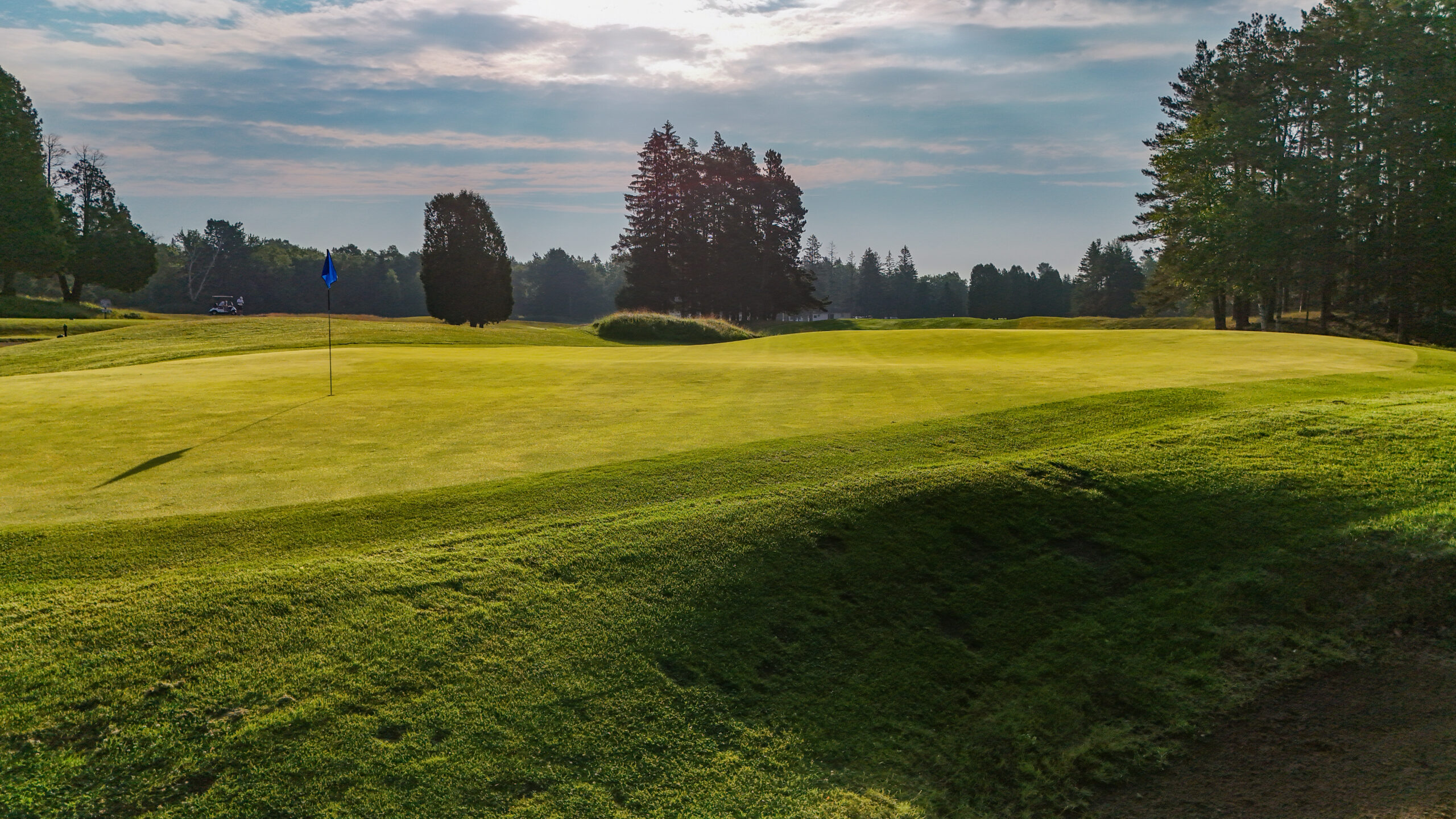
From behind the green and the original intended line of play after in-house renovations in the 1970s, the 4th green now slopes hard away from the player with the middle section acting as the “catchers mit”
Eighth hole, 177 yards; with the steeple of the majestic Paroisse Sainte Marie de L’incarnation looming in the background, this slightly uphill par 3’s highlight comes at the Walter Travis green, which is essentially an upside down “M”.
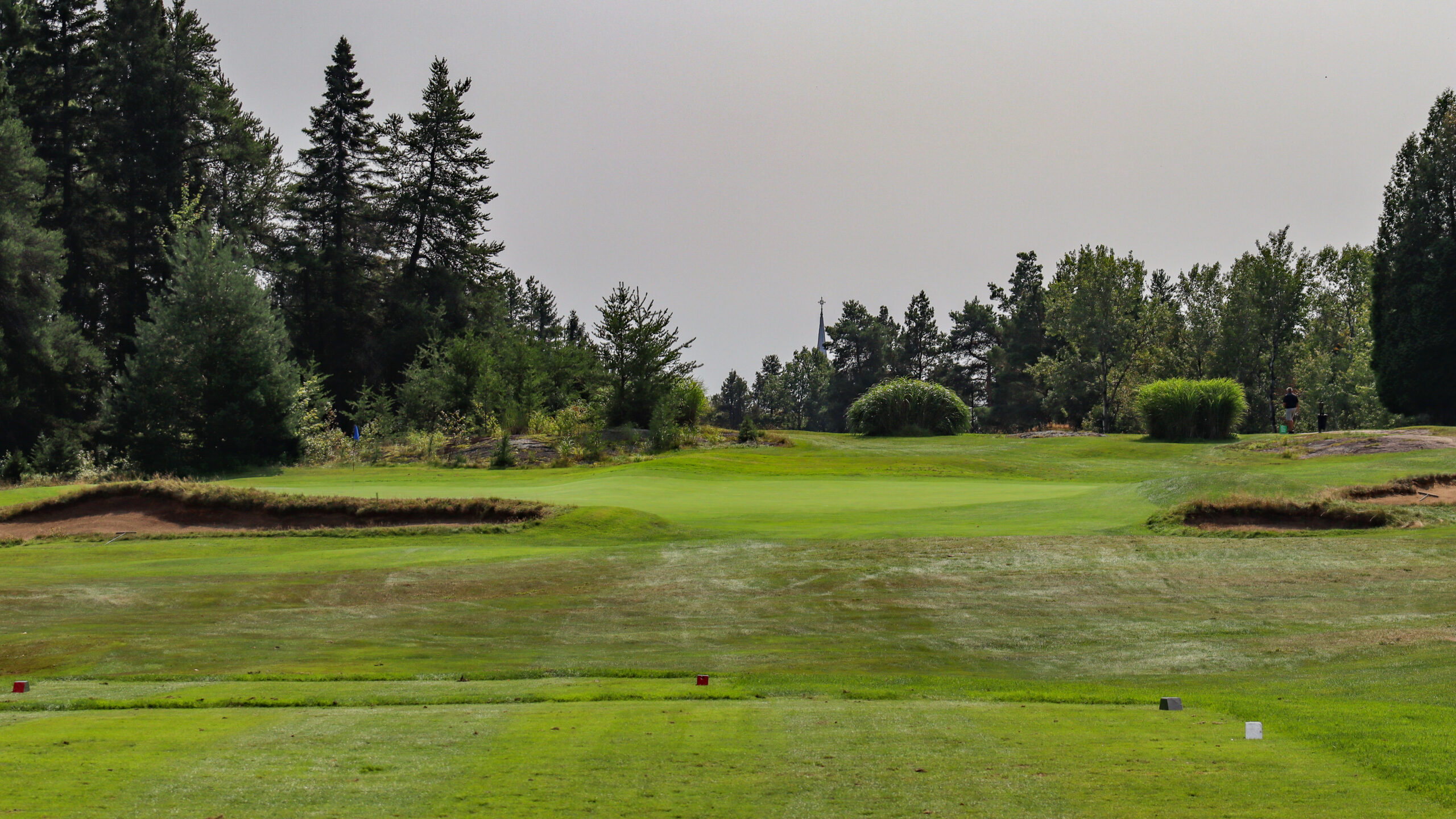
The middle finger of the M is a strong ridge of some foot and a half higher than the surrounding green surface, with it dividing the green into the left and right side. Jean Chrétien, Canada’s Prime Minister for a decade beginning in 1993, once famously quipped that depending on where the pin was, you were either on the French side (“the right side”) or the English side (“the wrong side”). When the pin is on the left, the front left bunker hides most of the surface; when the pin is on the right, it is accessible via the ground and visually appears much easier.
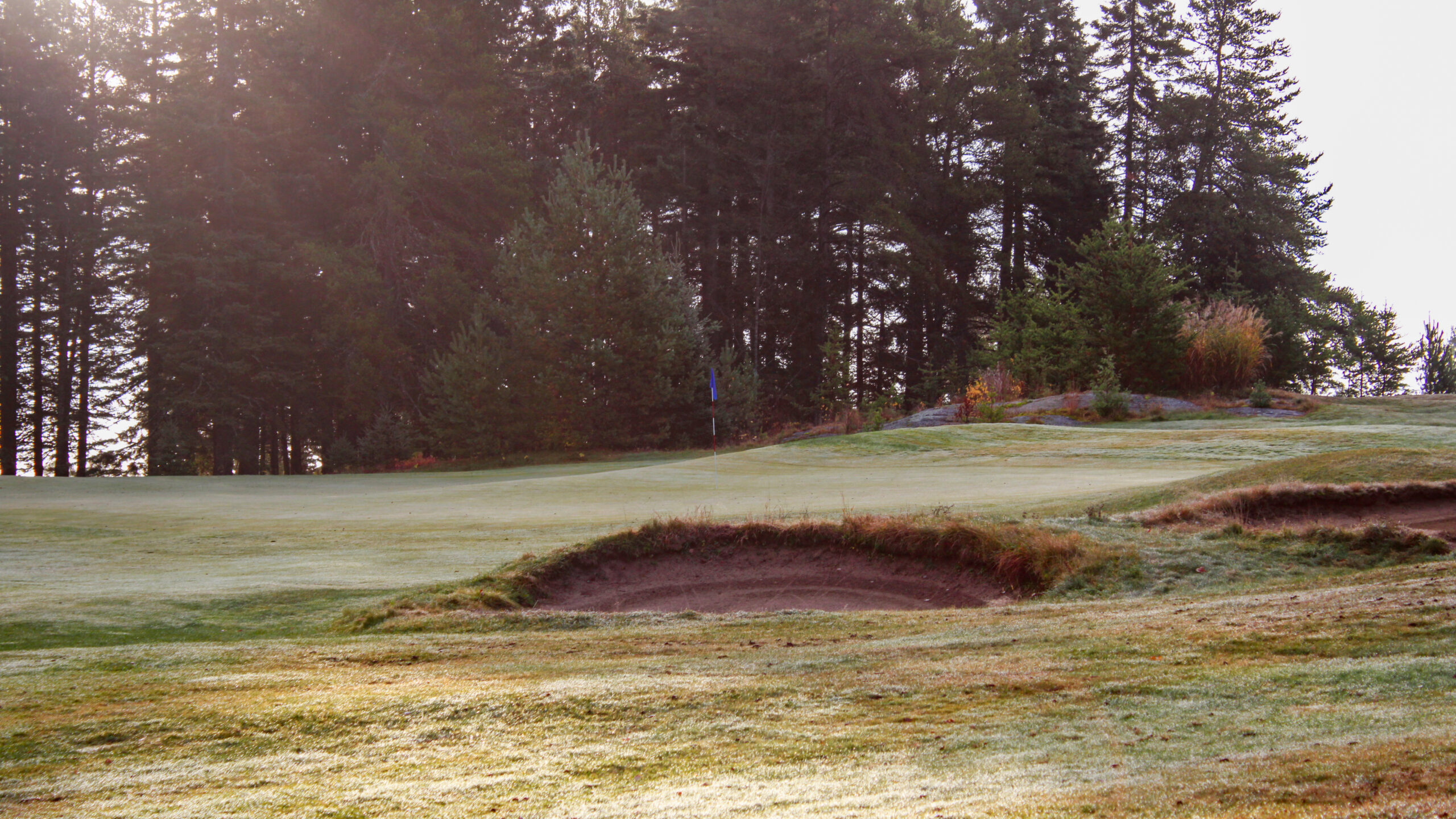
Ninth hole, 449 yards; After the opening five holes, the routing transports the golfer to a gathering spot atop a small hillside looking down to the 9th, running southeast, and the 6th, heading northwest. Here, likely the most breathtaking view awaits across the valley in the distance with the hole’s characteristics on full display.
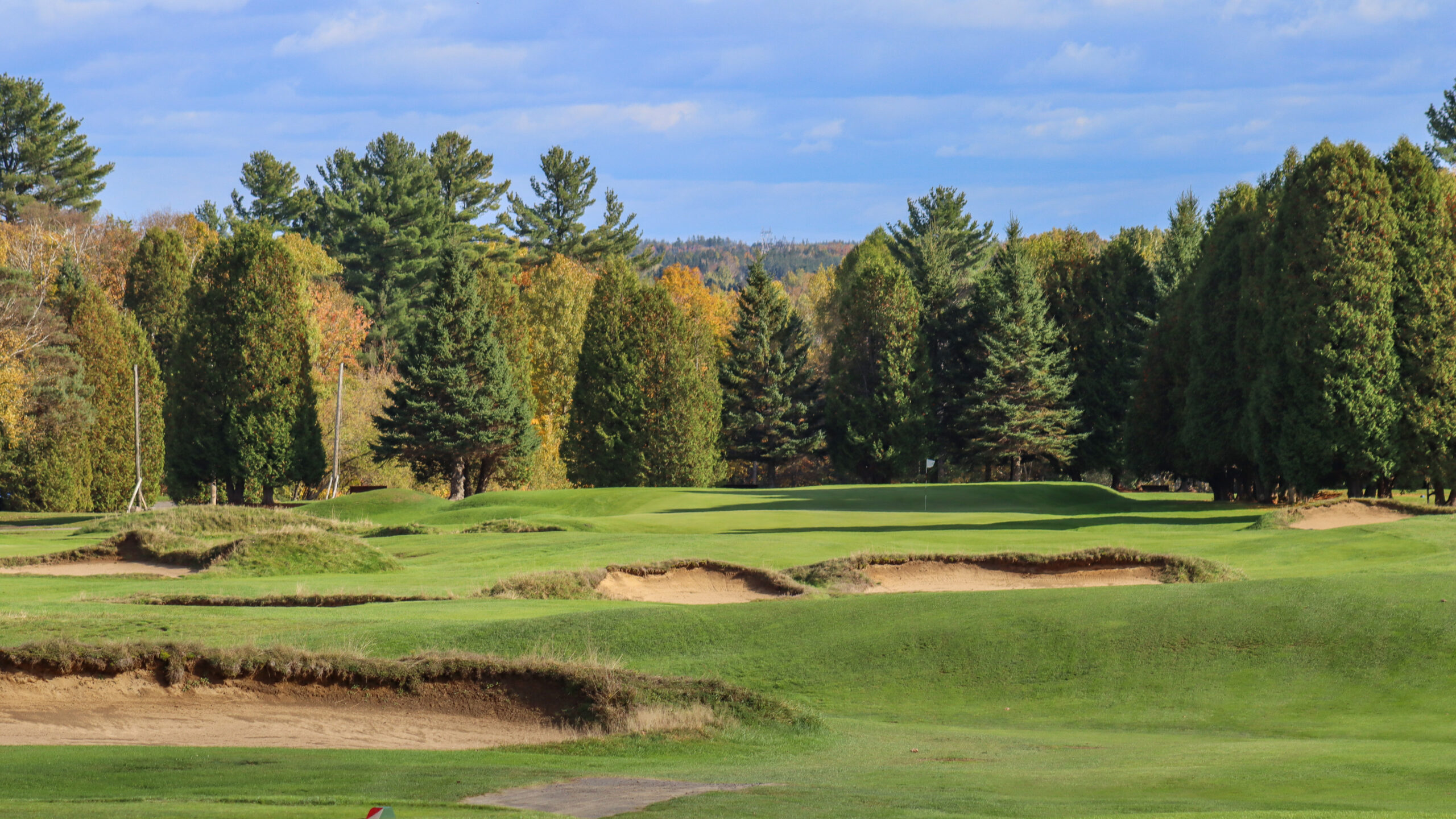
In the original Walter Travis sequencing, the golfer walked directly off the 5th hole to play the current 9th, which at the time was Travis’ 6th. Following C.H. Alison’s expansion to eighteen holes in the early 1920s, the 6th, 7th, and 8th were added and this became the 9th hole. With a panoramic view and an expansive, beautiful hole, Travis’ closing hole to the current front nine provides a sensory overload not seen at many places in Canada, especially when considering the old-school, almost heathland-inspired bunkers seemingly eating into the fairways. At the time of a golfer’s first visit, they might worry about the bunkers, but they merely provide a visual challenge on the opening swing and might come into play on the second shot if the first shot is not executed. Still! A mishit would end up in the bunkers up the left, and a firm, downwind bounce for the Tiger golfer could end up in the cross bunkers, originally built for the second shot on this used-to-be par 5. Various challenges await different skill levels, but one constant remains: this is a visually stunning, albeit challenging, swing.
Nonetheless, the hole is more than just a high tee overlooking the valley, with Travis’ green yet again stealing the show (a common theme on the outward nine). Best described as a Biarritz, Travis labelled this style of green as his “bathtub” greens. That is, a swale running east-west on the line of play dividing the higher back portion and higher front portion.

Tenth hole, 411 yards; Following the original sequencing of Travis’ nine holes, the 10th was his 7th hole and began a daring final three holes on the other side of the second canyon. As it stands now, it begins the back nine in a similar way to Pine Valley’s 6th hole with the fairway at an angle across the canyon, with the preferred line of play much more right than one thinks. Shades of Pasatiempo’s 10th are very obvious as well, which also begins the inward nine playing over a dramatic canyon.
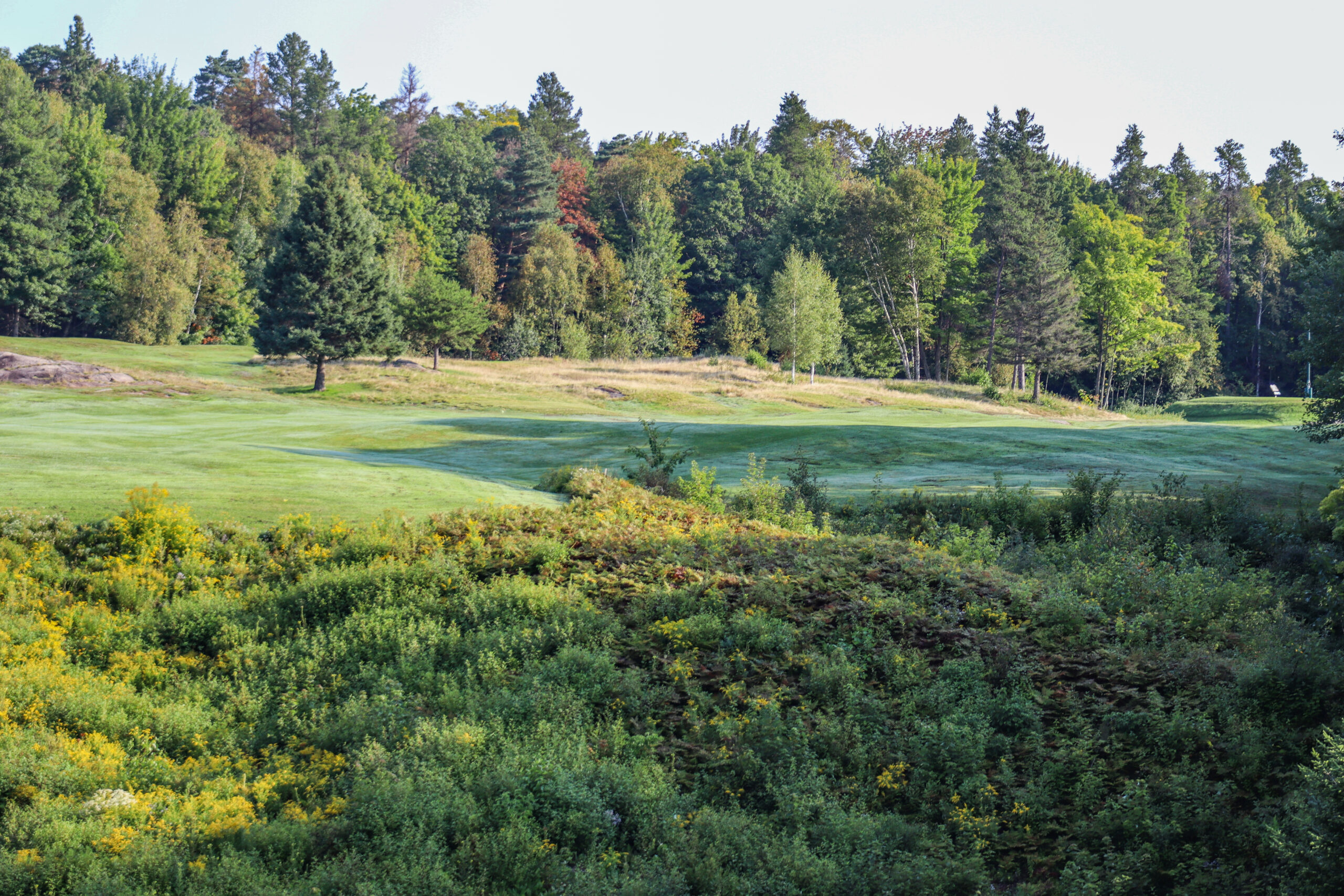
Believe it or not, the preferred line of play is just left of the sign on the 11th tee on the right side! First-time visitors often aim just right of the rock on the left side of the photo, marking a nearly 60 yard (!) spread between the most visually-comfortable line and the preferred line.
After navigating the tricky tee shot, the final Walter Travis green until the layout’s final hole awaits, but not without its own micro and macro contours in the fairway to further complicate the approach shot.
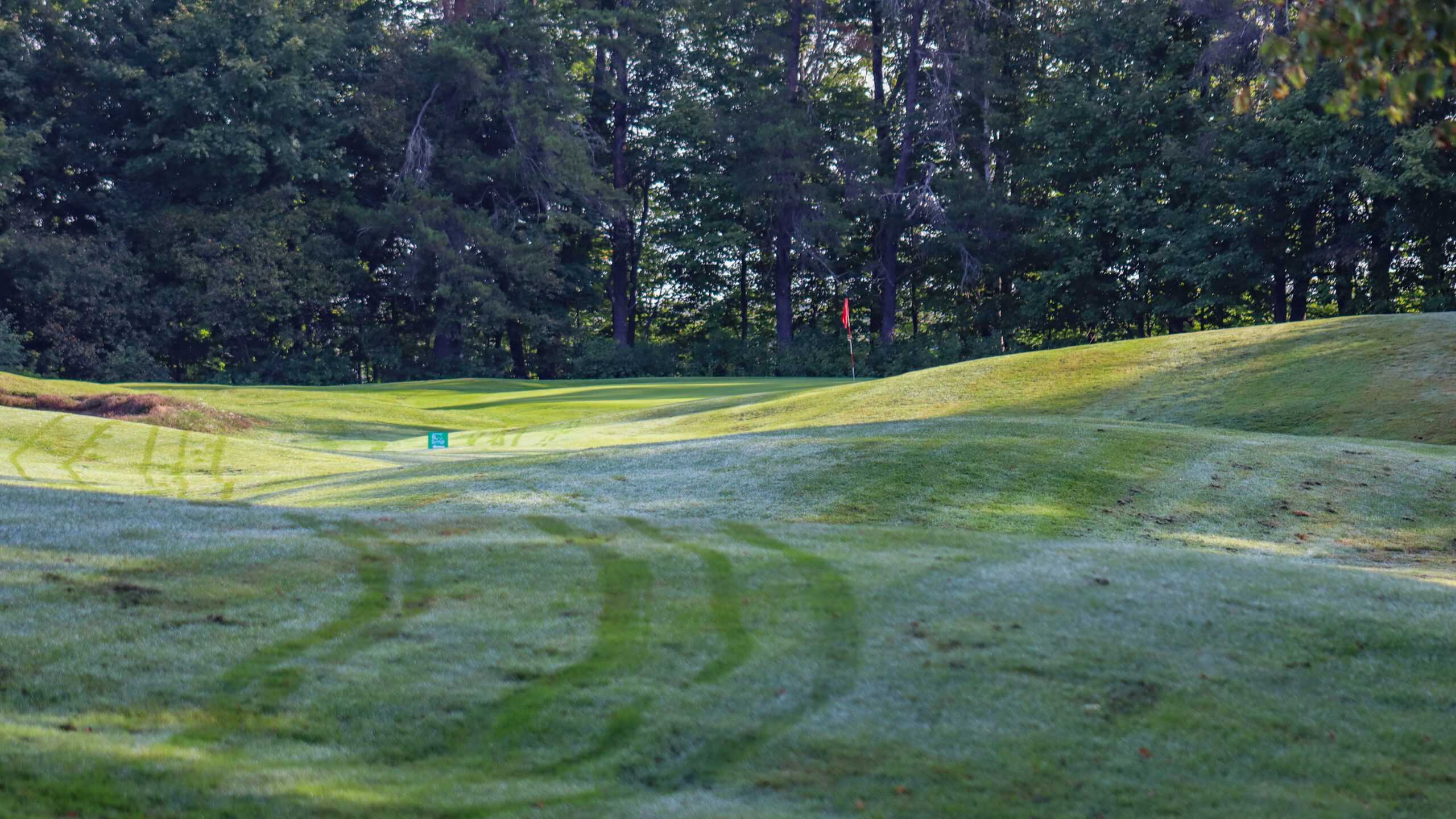
The tenth green sits so flush into the landscape you might think Travis simply just stuck a flag in the ground and decided to play to it!
Thirteen hole, 173 yards. In contrast to Walter Travis’ unusual architectural style with choppy contours and chocolate drop mounds, C.H. Alison is much more ‘smooth jazz’ against Travis’ ‘heavy metal.’ As a result, Alison saw the intensity the golfer faced on the 9th and 10th, especially after adding his own highlight at the 8th and decided to let the routing cool off ever-so-slightly on the 11th and 12th. Not that they’re bad holes by any means (rather, the way the routing works as a whole dramatically benefits from this decision as interludes), but they feel as if they’re transporting the golfer through the terrain as if they’re on a hike, waiting for the big reveal.
That big reveal comes on the stupendous par 3, 13th tucked in the most westernly part of the property sitting on the edge of a shelf with a severe fall off up the right.
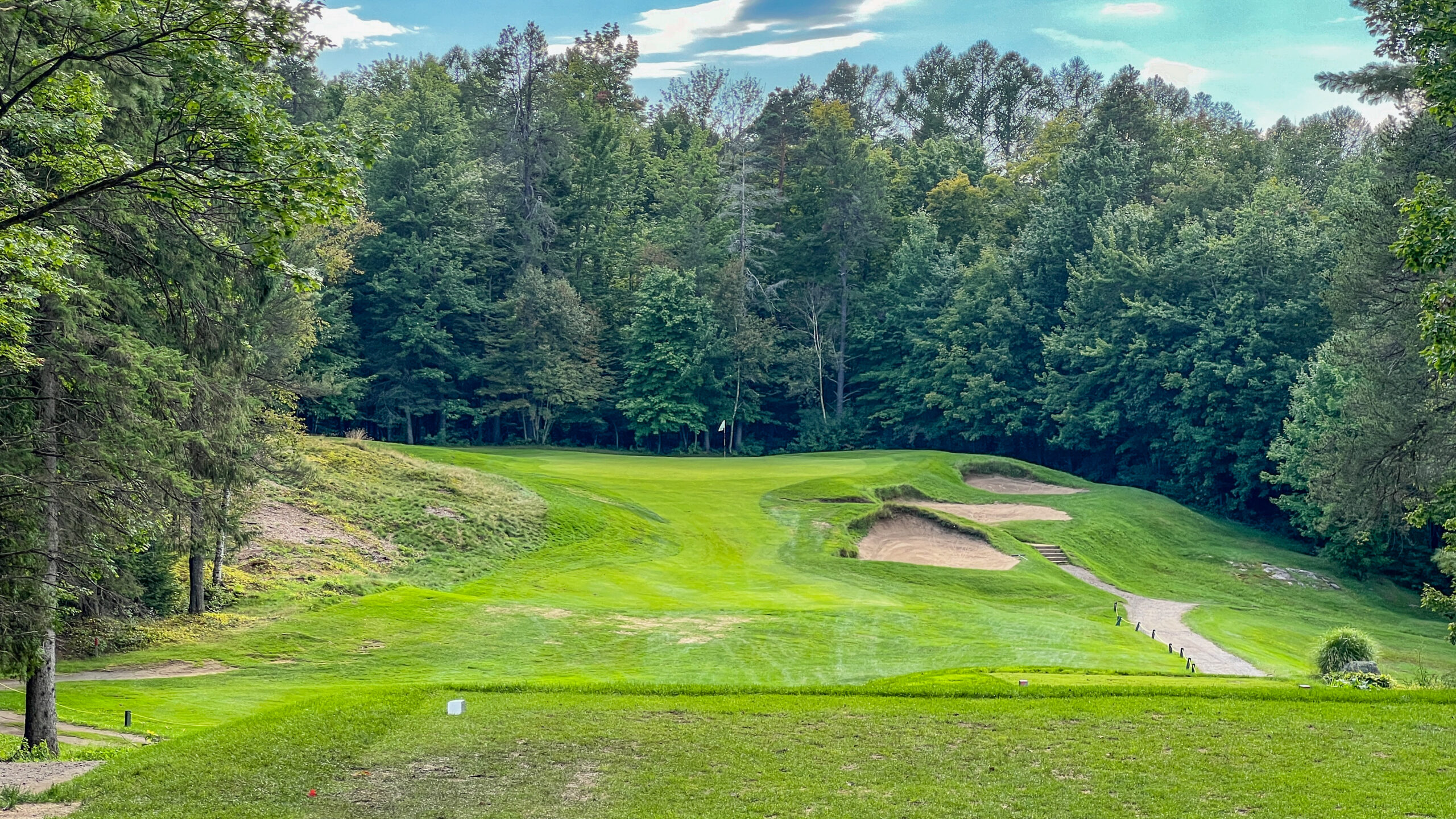
Fourteenth hole, 526 yards. After the 9th, the routing transports the golfer up the hillside into the tree and rock in a very spirited New England-esque way, with the 13th marking the climax of the holes in the trees and the rockiness of the property. The 14th brings the golfer back to a heathland-inspired open space conjoined with the 15th coming back towards the 14th tee.

The 14th green in the background, with the 15th flag in the foreground. Notice the texture: pines, fescue, natural tyme, bunkers, rough, fairway, and more (!). Splendid.
We’re skipping ahead, though! Standing on the tee, a massive flashed bunker awaits the right side, with a top-shot bunker acting as an outline for the hole’s width. Upon first play, this seems like a rather simple par 5: avoid the bunkers on the outside right side of this gentle dogleg left, but with repeat visits, one realizes this strategy is not only preferred, but enforced for those brave enough to try and get home in two. With Out of Bounds looming up the entire left side, and the green only accepting shots from the left (as well as the green’s surface sloping hard to the front left), Talking Stick’s famed 2nd hole comes to mind, with the golfer eventually having to challenge the left side in order to set up a reasonable chance to score. Knowing that, the line of play is anything left of the bunker, with the more aggressive line up over the small pines that line the internal corner.
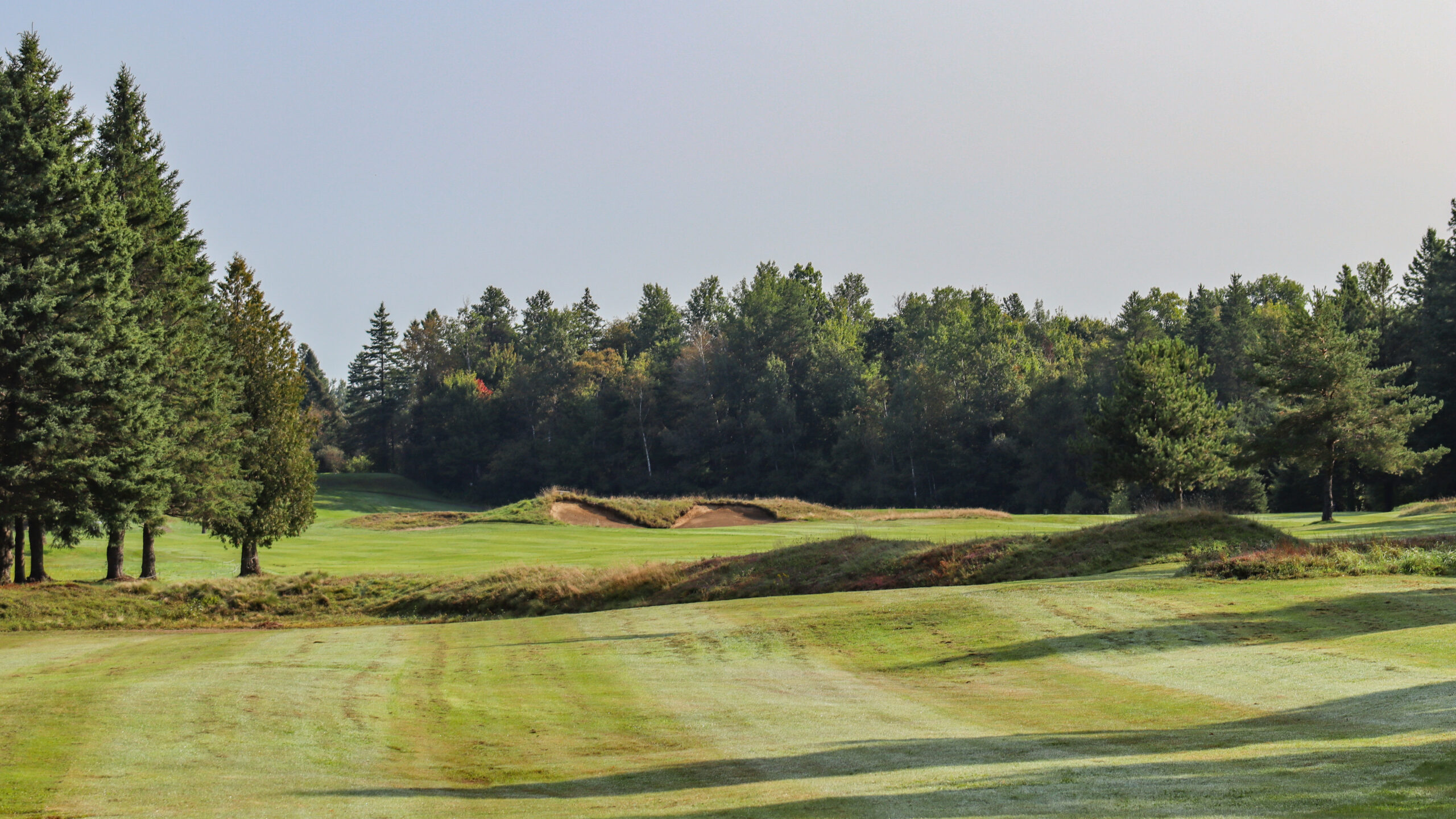
Turning the corner, the view of a superb Alison green complex shoved into the base of the hillside awaits:

A closer look, which has a bunker on the front right side, back right, and behind the green, with a small opening front left and open space up the left. The small, heavily-contoured green is a brilliant defence against those who can get home in two, with a difficult, high shot required into the surface, with anything missing right a difficult up-and-down. Sure, a miss left of the green is preferred, but missing too much means a ball Out of Bounds! Simplicity, yet beautiful strategy often produces the most alluring holes, and this is certainly the case here.

Sixteenth hole, 399 yards. Walter Travis and C.H. Alison contributed to the mighty feat that is Pine Valley near Philadelphia, with both architects coming to Grand-Mere shortly after their visits to George Crump’s dream. The most obvious callbacks come at the 10th with its angled fairway mirroring the famed 6th at Pine Valley, and the 16th with its split fairways between two crevasses seemingly drawing inspiration, too.
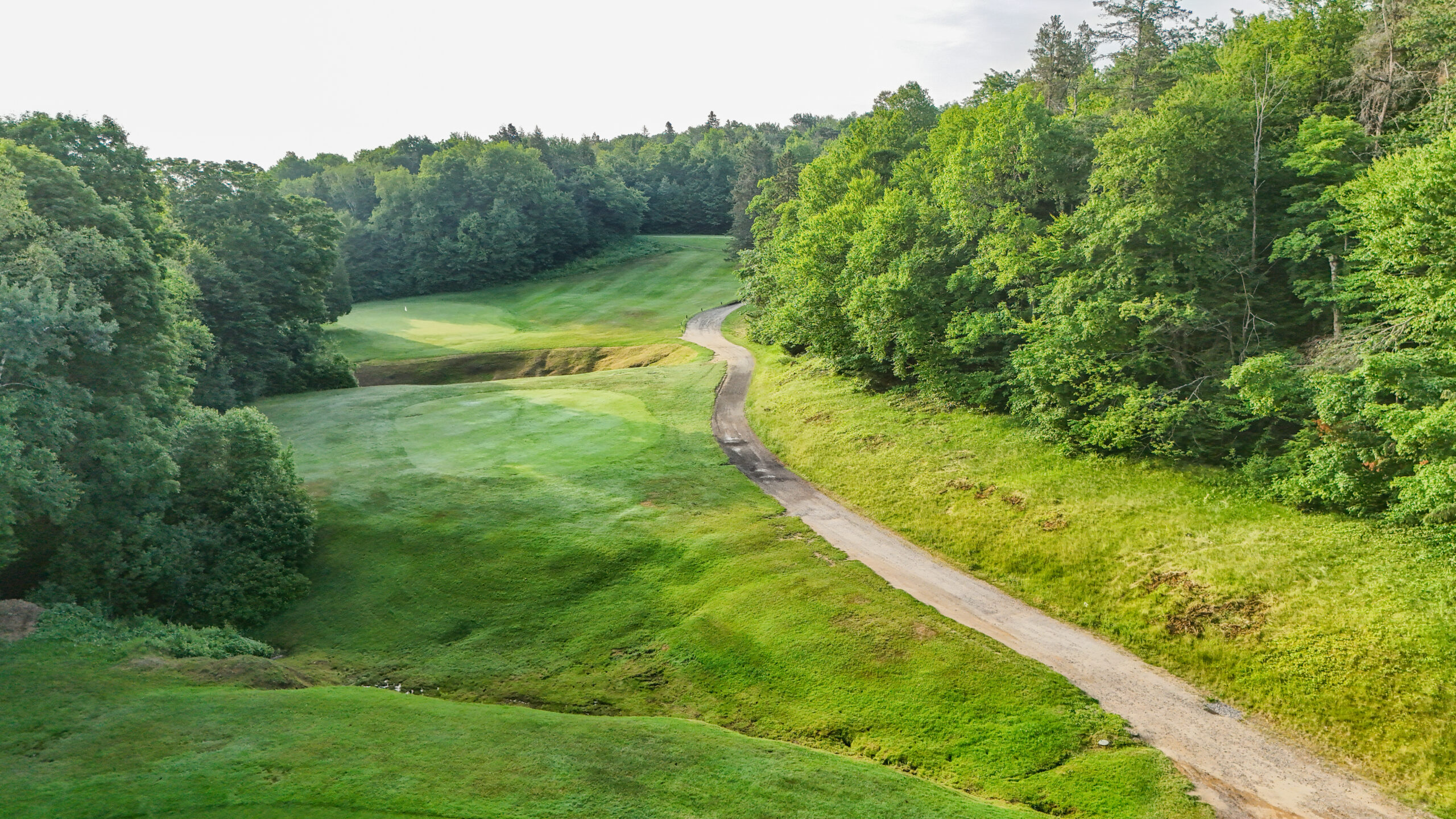
Of particular interest, the green complex is sublime sitting at the base of the hillside where the 17th tee (right) awaits. Those creavesses coming up from the left work their way off a depression, which awaits balls up the left side. The surface itself slopes hard to the front left, with a back right shelf and a flaired up back edge emphasizing the severeity of the back-to-front slope. It’s not uncommon to see a golfer bail out to the front right side of this surface considering what looms left, only to see them either have to aim away from the flag, or play the backstop.

Eighteenth hole, 448 yards. Various closing holes throughout the world of golf have a true sense of grandeur and significance as a way to end the round. Granted, many of these examples have been established over the years with the added pedigree and optics of championships, but other times, the architecture is more than up to the task of producing that feeling all the same. The 18th at Grand-Mere is certainly of that feeling, with the golfer teeing it up from the highest point of the golf course with the fairway some fifty feet below the teeing surface.

A dilemma awaits the final tee ball of the round: turn the ball around the corner, or play to the corner? The tee shot certainly pinches the golfer into a decision, with a true Tiger line over the tees on the left opening up a strong advantage for those who take less-than-driver and play to the corner. The scorecard says 448 yards, but in truth, it plays much longer for those who cannot turn the ball around the corner.
After doing so, a true exclamation mark on the golf course awaits with Walter Travis’ final contribution. Originally, Travis’ 8th hole played from the current 11 tee to a green sitting on the canyon the 10th hole (Travis’ 7th) played over, with the 9th hole as a middle length par 3 to the current 18th green. Upon Alison’s arrival in the early 1920s, he kept Travis’ green, but converted the hole into the beefy par 4 it is today. Travis’ green was originally intended to recieve shots from the north, with the current 18th hole heading east. As such, the contours of the green punish golfers coming from the outside side of the hole, or essentially, those not brave enough to get it to the hard inside-left corner. Anything from the right side of the hole will see the player attacking the hole to a green slightly working away from their line of play, while those from the inside corner reaping the benefits of working into the slope ever-so-slightly.

Until recent, Grand-Mere was a forgotten golf course in the Canadian golf scene. Why? With a golf course of this quality, one would think people would be chomping at the bit to get out here. Following the Laurentide Pulp Mill’s closure in the 1970s, Shawinigan’s industry (and status in Canada) diminished. Montreal and Quebec City continued to thrive, and much of the attention to rural Quebec turned to Mont-Tremblant and the Eastern Townships. However, Grand-Mere’s golf course is more than enough reason to make a visit, sitting essentially halfway between Montreal and Quebec City and jusy shy of the base of the Laurentian Mountain Range.
One perk of being essentially forgotten is how authentic Grand-Mere remains to the golf course Alison designed in 1922. In fact, only the 4th green has been significantly altered, and one might argue for the better! Seventeen green remain (they have shrunk over time, however), the routing is untouched, and other than twenty or so bunkers, the hazards are mostly there, too. In the world of golf, there are very few places to seek out such holistic Golden Age experiences, but Grand-Mere is certainly one of those.
In 2022, the club announced that Andy Staples would be overseeing the restoration of Grand-Mere, which is largely fine-tuning and polishing. That includes the restoration of lost bunkers, tree removal, grassing and mow lines, green expansion, and adding some length to restore the shot characteristics (or at least get closer to) of the original layout. Upon publishing this in November 2024, work has already begun, with tree work on a handful of holes, as well as new tees on the 12th and 18th being the first improvements. With a small polish and tree removal, one wonders how high Grand-Mere can possibly be thought of in the world of golf given the astounding architecture found throughout the property. For now, it remains one of the best values in golf ($39 CAD), all while being a true time machine to the Golden Age of Golf Architecture.


